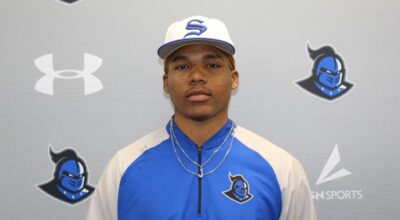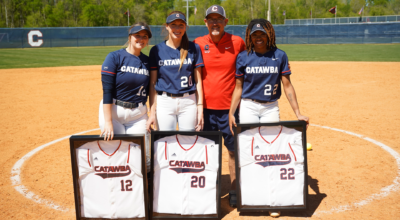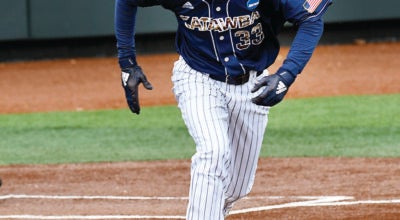Pipe dreams: Jarrell gave Newman Park bones of steel
Published 12:15 am Thursday, July 23, 2015

- JON C. LAKEY / SALISBURY POST FILE PHOTO Newman Park at Catawba College was originally built in 1934 by A.L. Jarrell & Sons. The grandstand (center) is made of wood and tubular steel from Spencer Shops, now the N.C. Transportation Museum.
SALISBURY — When James Jarrell sits in Newman Park and takes in American Legion baseball games, he can’t help but think of his long departed father.
A.L. Jarrell Sr. was the definition of a self-made man. Though he possessed only a grammar-school education, Jarrell was always innovating, always “reading and figuring,” his son says.
He also chewed tobacco constantly, and you have to wonder if any of the infrastructure at Newman Park is still stained with his tobacco juice. You see, Jarrell and his company built Newman Park, whose step-back-in-time, 1934 grandstand makes it one of North Carolina’s oldest baseball venues.
Look closely and you will notice the tubular steel from Spencer Shops that A.L. Jarrell & Sons used to construct Newman, which sits at the foot of Summit Avenue on an edge of the Catawba College campus. Starting Friday, it will be home to the N.C. American Legion Baseball Tournament, which includes Rowan County and seven other top teams in the state.
James Jarrell will be there.
His father’s unique tubular steel trusses formed the structural framework for more than 30 ball parks and football fields. A.L. Jarrell & Sons — five of his six sons would go into business with their dad — once built the baseball grandstands for Appalachian State and East Carolina universities.
The company constructed the grandstand for Finch Field in Thomasville in 1937 and Holt-Moffitt Field in Lexington in 1938. The old pipe-construction Shuford Stadium at Catawba College, torn down in 2001, was built by Jarrell — as was today’s modern version.
A.L. Jarrell recognized a good thing, and he also used tubular steel construction in hundreds of airport hangars and tobacco warehouses and numerous exhibition halls on state fairgrounds. Jarrell crews worked in North and South Carolina, Georgia, Virginia, Tennessee and Florida.
“We were the only ones around who did it,” James Jarrell says. “Anytime you see trusses like this, he did them.”
Even the Jim Shoaf Barn Dance, off U.S. 601, has the Jarrell tubular trusses.
Rowan County is filled with other buildings that Jarrell & Sons, now Jarrell Contractors Inc., also constructed over the years. Examples are the old Frito-Lay, Leisure Lads and Loeblein furniture plants; General Electric; United Parcel Service; and the Salisbury Post Office at East Innes Street and Martin Luther King Jr. Avenue.
Today the company, which has fourth generation family members still involved, is building mostly school additions, small churches and light distribution centers.
“If you were a family member,” Archie Jarrell fondly recalls, “Granddaddy believed in feeding you, not paying you.”
A Greensboro native, A.L. Jarrell first worked as an apprentice machinist with the Newman Machine and Foundry Co. He moved to Salisbury in 1908, and was employed at Southern Railway’s Spencer Shops until 1920.
It was probably during those years that Jarrell began thinking about the possible construction uses of steel pipe Southern no longer needed.
But first he opened up the Midway Motor and Machine Co. on North Main Street and also started the city’s first Oldsmobile dealership. He installed the first electric welding machine in the state in 1921, and when the Buck Steam Station’s initial unit was built in 1926, he had the contract for all the welding.
From 1927-29, Jarrell sold more Oldsmobiles than any other dealership in the state. He apparently polished his idea of tubular, welded steel trusses in 1927 and employed them when he expanded his own building on North Main Street.
By 1930, Jarrell changed the company’s name to A.L. Jarrell & Sons Fabrication Co. and fully launched into construction. James Jarrell says his father, who died in 1963 at the age of 72, often ended up showing college engineering students and representatives for national steel companies how to do the calculations on round steel.
“And he didn’t finish the fourth grade,” says James, who worked for the family business into the 1990s, then did house appraisals until retirement. Of A.L. Jarrell Sr.’s nine children, he’s the only one living.
James Jarrell smiles when he recalls how the fieldhouse at Newman Park was built in the early 1960s. Bone Hamilton had plans to bring a professional team into Salisbury, but one of the requirements to be part of the league was to have a place for players to shower.
City and county officials turned down his requests for money, so Hamilton went to Jarrell and offered him stock in the minor league team in exchange for building the fieldhouse, which is still used today.
“It wasn’t worth anything,” James Jarrell says, and the Jarrells never saw any return on their stock. But it makes a good story.
Newman Park seats between 1,500 and 2,000 people, depending on how the fans are squeezed in. Through the years, it has been home to Catawba College, Rowan County American Legion and various minor league teams between 1935 and 1968, though not always continuously.
Mention should be made of Dr. Harold Hastings Newman, the Salisbury surgeon, church and civic leader and baseball enthusiast for whom the ballpark is named.
Newman was a native of Woodstock, Va., who was an outstanding catcher and captain of the Randolph-Macon College baseball team.He also was a first-string catcher at Johns Hopkins Medical School.
Though he was invited to play for the Baltimore Orioles, Newman decided to stick with a medical career instead. He came to Salisbury in 1914 as an assistant to Drs. John Whitehead and J.E. Stokes, and he was in general practice here until 1922, when he went off to the Mayo Clinic and returned a surgeon.
Newman and Dr. James Ramsey served as the first baseball coaches for Catawba College in the 1926 season, after the school had moved here from Newton. The team went 7-6.
But the ballpark probably carries Newman’s name because of his leading role, starting in 1932, to raise money for its construction. It eventually was named for him in 1935.
As evidence of his love for baseball, Newman organized the Carolina League, an independent, semi-pro group of teams, before the professional league of the same name got going. He was the Carolina League president in 1934-35 and vice president of the Class D North Carolina State League in 1938.
Newman died of a heart attack in 1951 when he was 62.
There have been rumors and lots of talk this year that immediately after the state Legion tournament, construction crews would be coming in and tearing down Newman Park’s old grandstand and bleachers to make way for something new.
Those plans seem to be on hold for now.
James Jarrell loves the partnership Legion baseball and Catawba College have forged through the years, and he only wants to see that continue. He won’t complain about change when it comes, even though his family’s DNA runs through the old ballpark.
“You know, time goes on,” he says. “We need a new field, and I hope they make this thing a showplace.”
Contact Mark Wineka at 704-797-4263, or mark.wineka@salisburypost.com.





